The Clash of Two Super Middleweights: KTM 890 Duke R Vs. Triumph Street Triple RS

Will the upstart usurp the standard-bearer?
As of 2015, the sport of boxing has a total of 17 different weight classes. For a while before that there were only eight, and during the sport’s early days there was only one – heavyweight. These two machines certainly aren’t heavyweights, and as I looked down the weight categories, cruiserweight sounded more apt for a future test of American iron, and light heavyweight is an oxymoron. After that, there’s super middleweight, a class slightly heavier than your regular middleweights. Perfect.
2020 KTM 890 Duke R – First Ride Review
2020 Triumph Street Triple 765 RS Review – First Ride
Boxing parallels are somewhat common whenever you put two competitors against each other. So, forgive me for doing it again with the title of this test – but there’s a method to the madness. Just calling the KTM 890 Duke R and Triumph Street Triple RS naked bikes doesn’t do either justice. Their mid-displacement engines hold them back from true streetfighter status, too (at least based on my arbitrary rules that I’m making up as I type this sentence). But these two motorcycles certainly are special, and with motorcycling (or maybe it’s just moto-journo hacks like us) continually defining itself into smaller and smaller sub-categories, sometimes it helps to draw inspiration from outside the sport.
From the moment we first threw a leg over the KTM 890 Duke R, it was clear that it was going to be a contender for all kinds of awards and accolades. It’s a damn good motorcycle, highlighted by an engine that instantly put a grin on our faces. But there’s another motorcycle out there, similar in many ways to the KTM, also with a grin-inducing engine – the Triumph Street Triple RS.
The Same Thing, All Over Again
If you’re getting the feeling of deja vu, like we’ve already done this – we did. Sorta. The important distinction is that test was between the 790 Duke and Street Triple R. This one ups the stakes with the 890 Duke R and Street Triple RS. While both are visually very similar to their counterparts we tested a year ago, a series of choice upgrades help both up their performance levels considerably.
With the KTM, the obvious difference is the bigger engine, but you also get upgraded WP suspension, updated electronics (still using an IMU), and Brembo brake components with larger discs. On the Triumph, you’re still using the 765cc Triple, but the RS gets more power out of the three cylinders. Other upgrades include a quickshifter in both directions, fully adjustable Öhlins STX40 shock, and Brembo M50 calipers.
A Disruption In The Force: KTM 790 Duke Vs. Triumph Street Triple R
On paper anyway, this matchup between the 890 Duke R and Street Triple RS couldn’t be more perfect. Since the Triumph makes more power with the RS than it does with the R, the KTM’s bigger displacement provides more parity (more on that in a moment), and the higher-spec suspension and electronics between both models also make for a fairer fight. Then, there’s the cost. At $11,699 for the 890 Duke R and $12,550 for the Street Triple RS, it’s entirely within reason to think a consumer would be cross-shopping these two models (and, in fact, we personally know people who were).
As is our standard procedure, we put both bikes on the dyno, weighed them with full fuel loads, and logged miles on the street and on track. Specifically, we joined our friends at Let’s Ride Trackdays for a day at Buttonwillow Raceway to let each bike flex its muscles. We leveled the playing field on both bikes by swapping the stock rubber with the excellent Pirelli Supercorsa TD. We really didn’t need to do this, as the Michelin Power Cup II and Pirelli Supercorsa SP that come standard on the KTM and Triumph, respectively, are quite good, but our 890 test unit’s rubber was looking fairly worn (and no replacements were available), while the Street Triple’s tires were brand new.
No Ducati?
More than a few of you said you wanted to see the Ducati Hypermotard thrown into this mix. We did, too. It’s hard to classify the Hyper, but putting its looks aside, the riding style jives perfectly with the KTM and Triumph – all three test your levels of self-control and ability to not act like a hooligan at every opportunity.
But at $13,395 for the base Hyper, it costs more than the KTM and Triumph and gets “basic” Marzocchi/Sachs suspension components. We were willing to overlook both those things, plus the fact that, with its claimed 114 crankshaft horsepower, its 937cc Testastretta L-Twin comes up a little short compared to the 890 and STRS because we know as well as anyone spec charts can never reveal a bike’s true character. However, the Hypermotard isn’t here for one simple reason: Ducati didn’t have one for us to test within our timeline.
A Tale Of Two Engines
Back to the task at hand, we start this test with a revelation of how equal, yet different, both bikes are. Strapped to the roller on the MotoGP Werks dyno, both the KTM and Triumph put down 116 hp to the wheel – 116.2 hp for the KTM, 116.6 hp for the Triumph. The KTM, however, reaches its power peak at 9,500 rpm while the Triumph gets to 116 hp at 12,100 rpm. At 9,500 rpm, when the KTM is at its peak, the Triumph is hovering around the 100 hp mark.
This points to something more revealing about both bikes. Take a closer look at the dyno chart, and you’ll see the glaring difference between these two: the KTM makes significantly more power than the Triumph until redline. It isn’t until the 890 signs off that the Street Triple’s 765cc three-cylinder makes up the gap.
It’s a similar story on the torque front, except the Duke wallops the Street Triple throughout the rev range en route to its 70.2 lb-ft. peak. Compared to the Triumph’s 56.3 lb-ft. peak this is a difference you can feel. Especially on the street.
As Ryan “Ear Holes” Adams puts it: “On the street, you’re less likely to be revving the [Triumph] motor up into the meat of the powerband, but what you do get is a continuous delivery of power and torque that’s mild-mannered while still having the ability to quickly catapult you to ticket-inciting speeds should you stay on the gas.”
Meanwhile, on the KTM, Ryan notes: “The torque of the latest KTM Parallel Twin is addicting and brutal. Hard on the gas while flipping through first, second, third, fourth, and fifth gear all have the potential to loft the front end. KTM could take some notes from Triumph though when it comes to fueling. Riding Evans’ remapped, Power Commander V-equipped 790 shows just how smooth the mill can be. So, it’s not a deal-breaker, but it’s definitely one of the bike’s few weak points.”
I’ve never been one to call the 765cc Triple underpowered, but when you ride it back-to-back with the 890, the KTM clearly leaps off the line or out of corners with noticeably more ferocity than the Triumph. Even rolling down the freeway, when you need to overtake someone, the KTM is eager to do it. In comparison, the Triumph… proceeds. You have to continually keep the Triple revving to keep pace – an easy feat considering how nice a wailing three-cylinder is to the ears.
On track, where you’re high in the revs anyway, the Triumph’s torque deficit isn’t much of a factor, but since both bikes make the same power and only weigh within eight pounds of each other – 408 lbs for the KTM, 416 lbs for the Triumph (ready-to-ride, with a full tank of gas) – both bikes feel neck and neck in regards to straight-line speed. The Duke’s torque gets better drive out of corners, but because the Triumph is revving higher, it sounds faster. The real adjustment when hopping off one and to the other is remembering the different shift points needed to keep each in their respective sweet spots.
Ryan noted the Triumph’s fueling as “precise,” a description I agree with, with very little on-off throttle jerkiness or lag. The same can’t be said about the KTM, at least in Track mode, the most aggressive of the riding modes. On/off throttle transitions bring up some lurchiness in the power delivery, though it never really bothered anyone on the street or track. Again, it’s one of those things you really notice when hopping off one and going directly to the other.
KTM 790 Duke Project: Building A 790 R
If this worries you, there’s good news: an ECU tune should do wonders for cleaning up the abrupt throttle. How do we know? Because Evans brought along his 790 Duke, complete with Power Commander V recalibration, and it only took one session to see the difference in fueling – Evans’ bike was especially clean and linear on the bottom compared to the standard 890.
Gearbox
Which brings us to another topic – shifting. “As different as the two motors are,” says Ryan, “the transmissions are equally at opposite ends of the spectrum.” The Triumph’s quickshifter is silky smooth, up or down, clicking into any gear with a flick of the toe. Even the 1-2 shift is nice and clean. Our original KTM test mule, meanwhile, was seemingly impossible to shift without using the clutch, especially from first to second. No matter how hard we pressed up with our foot, sometimes it just didn’t want to shift via the quickshifter. I noted in my 890 First Ride how the transmission felt notchy. Aboard this test bike, it was flat-out bad. As if there were a terribly bent shift fork.
A call to KTM cleared up a few things. First, we were informed the hard shifting was due to a software calibration issue within the quickshifter on our pre-production test bike and not a mechanical problem with the transmission itself. Dealerships are supposed to update this software before handing the keys over to a customer. Second, we were given a different, software-updated, test bike to continue our test with and this unit, while drastically improved over our original tester, still couldn’t match the Triumph when it came to clean shifts.
Just as with the engine, however, after riding Evans’ 790 Duke, equipped with the same quickshifter, changing gears is just fine, which leaves us feeling a little more comfortable KTM reps weren’t just blowing smoke at us. Still, as Ryan notes, “the Duke’s transmission is the Achilles heel of the bike.”
Handling
It probably doesn’t come as much of a surprise that getting around a corner or two, whether on the street or the track, is an area both motorcycles excel in. Both bikes feature fully-adjustable suspensions, which actually respond well to inputs. On the Triumph, we commend Showa’s 41mm Big Piston Fork for soaking up bumps nicely right out of the box, the only change we made was adding a little more preload at the track for better composure under braking.
Initially, the Öhlins STX40 shock was delivered to us with its compression circuit one click away from being closed off. As you can guess, the resultant ride was stiff and bumpy. Backing out the adjuster five more clicks made a big difference in ride quality and chassis compliance.
There’s more of the same on the KTM’s side. We hardly touched the WP 43mm Apex fork since we didn’t feel the need to, but we did anyway to see how effective the bike responds to changes. Thankfully, some bright minds at WP affixed wingnut-type adjusters to the top of the fork to make rebound or compression changes tool-less, since the handlebar sitting above it would block access if you were trying to use a flat head screwdriver. Luckily the Triumph’s bar sits just far enough below the slots to be reachable with a long screwdriver.
On the shock side, WP’s Apex unit is also fully adjustable, and again only minor changes were made to get the bump absorption we preferred.
Chassis-wise, however, the Street Triple and Duke take different approaches to attacking a curve. The Triumph’s 23.9º rake is slightly more aggressive than the KTM’s, and its shorter wheelbase helps it bend into corners quickly. On the Duke, its 24.3º rake is a hair less aggressive than the Triumph, and its long swingarm lends to its 58.3-inch wheelbase, three whole inches longer than the Street Triple (both have identical trail numbers – 3.9 in.). Theoretically, the KTM’s much longer wheelbase shouldn’t let it steer as quickly, but its wide bar lets you manhandle the Duke to your will, proving again that all the spec chart numbers don’t always give you an accurate portrayal of what the bike will actually be like to ride.
Ryan points out another bonus for the KTM: “Despite weighing only eight pounds less than the Street Triple, the 890 Duke R feels 50 pounds lighter when slicing through a section of corners. It really is a svelte package.” KTM nailed it when dialing in the 890’s center of mass, as it truly feels lighter than the scales tell us. Ryan continues, “The Street Triple RS never really struck me as being sluggish in the handling department, until I rode the 890 Duke R. It’s pretty remarkable how big of a difference there is.”
Tossing a bike into a turn is one thing, but how it feels once you’re leaned over is another. Once you combine bumps in the road, speed, and lean angle, the Triumph claws back some ground. “Where the Triumph’s handling shines is in mid-corner stability,” Ryan says. “The KTM can, at times, feel nervous with its less-than-stellar fueling and razor-sharp handling…” Suspension changes we made throughout the day at the track minimized these issues, but the difference was still noticeable.
Ergos
If you’re noticing a trend so far, it’s about how differently each of these machines achieve their shared goal of hauling ass. Those differences extend to how you sit on them. Here’s Ryan again: “Keeping with the night and day theme we see going here, the Street Triple’s saddle is infinitely more comfortable – and lower – than the 890 Duke’s flat, hard seat. The Triumph’s narrower handlebar and higher footpegs make the entire rider triangle feel more compact, whereas the KTM has a much more open cockpit – something I actually preferred at the track.”
While I mostly agree with my tattooed compadre, my preferences are a little more nuanced. The lower pegs and more spacious, albeit harder, seat of the Duke was my pick on the street. I liked being able to move around and stretch my legs on those freeway drones, and the slight forward cant had less of a sail effect on my chest.
The Triumph’s seat is considerably more cushioned, but its pegs are also noticeably higher and bars are slightly closer to the rider. This combination locked me in place more than I’d prefer on the street and had me feeling a little sail-like on the freeway.
On track, however, my preferences shifted. Suddenly I was moving around more than I wanted on the KTM, with nothing to lock into. My arms would be doing extra work keeping me from scooting too far back on corner exit while unleashing the Duke’s healthy power. This simultaneous action of twisting the throttle while also bracing my arms to keep myself in place drains energy and sometimes leads to unwanted twists of my wrist. The Triumph’s tighter confines helped keep me in place at full lean, during transitions, and especially on the gas, so my arms could stay relaxed while accelerating and my legs could keep me in place.
Electronics
Motorcycles are nothing these days without a proper electronics suite, and in this category there’s an important distinction to be made – the KTM has an IMU (Inertial Measurement Unit) while the Triumph does not. This makes all the difference, as even though both bikes have traction control and ABS, the IMU enables the KTM’s traction control to be applied in a much smarter, subtle, and progressive way. In short, it’s barely noticeable. The KTM also comes with Cornering-ABS, too.
The Triumph’s traction control, with its lack of an IMU, is much more archaic, relying on wheel speed sensors exclusively to react to spin instead of predict it. What’s worse, the TC sensitivity is directly tied to the different riding modes and can’t be changed independently like on the Duke. The result is a system that can step in too early and for too long, with the power interruption feeling a lot like turbo lag. One moment you have a certain amount of power as TC intervenes, then when TC finally lets up – bam. You get all the rest. Subtle it most certainly is not.
Here’s some good news: both bikes use a TFT display to show you information. Both are easily seen in direct sunlight, too. On the Duke, the menus are easy to manipulate and toggle through via buttons on the left bar. The Triumph has buttons and a mini joystick on the left bar, but it also has buttons on the right bar. I suppose if the Street Triple were your only bike, you’d get used to the switches and buttons quickly, but they’re less intuitive than on the KTM. What’s worse, the Triumph allows you to toggle between four different screen layouts – none of which have an easily readable tachometer.
Brakes
When it comes to stopping power, both the Triumph and KTM scrub off speed just as well as anything out there. Ryan notes, “like the suspension, both bikes use topshelf componentry in the stopping department, too.” We’re talking Brembo MCS master cylinders and Brembo calipers.
The difference, in case you couldn’t tell by now, is in the details. The KTM gets 320mm rotors compared to the 310mm discs on the Triumph. Higher-spec Stylema calipers on the Duke are just a nudge higher on the Brembo ladder than the M50s on the Street Triple. To be fair, both systems are excellent, with all the power and linearity you could ask for in a production bike. But it’s our job to split hairs here, and Ryan and I agree the Duke has the slightest edge. Coming equipped with C-ABS and the ability to turn off rear ABS seals the deal in the 890’s favor.
Looks
Neither Ryan nor I are exactly ones to talk when it comes to the looks department, especially now that social distancing has made it a little tricky to get a haircut, but we both agree the KTM looks striking. From its angular design, to its weird front headlight, to its orange frame and wheels, the 890 Duke R just looks the part of a mini streetfighter. We like that.
It’s not that the Triumph is a bad-looking motorcycle, and considering how subjective this subject is, you might have the complete opposite opinion as Ryan and I do anyway (Evans does). However, to us, Triumph’s modern take on the bug-eye headlight thing made popular by the original Speed Triple all those years ago is starting to look a little…dated. Show us something new, Triumph.
And The Winner Is…
It might seem like we’re bashing the Triumph here, but this really isn’t the case. It’s simply a matter of highlighting the differences we may normally gloss over because these two really are so closely matched. The last time we had a Duke and Street Triple together, we noted how difficult it was to pick a winner between the two. Both are exceptional machines, going about their business in very different ways. Then, like now, picking a winner was hard.
The Street Triple’s three-cylinder wail is as intoxicating as ever, but the Duke’s brute power has its own unique charm. The Triumph has a small edge in the handling department, but the KTM isn’t far behind. Looks are obviously subjective, but both Ryan and I lean towards the Duke. As far as brakes go, they’re virtually even.
For me, the KTM’s grunt is more usable than the Triumph’s top-end, its brakes are a tad better, and the cherry on top is how much more sophisticated the 890’s electronics are compared to the Street Triple. Oh, and it’s cheaper, too.
Ryan agrees: “If I’m spending my money, the KTM is the bike I’m going home with. It’s slightly less expensive and addresses the ergonomic issues I had with the 790 Duke, all the while sporting a torque monster of a motor and more adjustable electronics. Knowing that our two major issues with the orange bike are (relatively) easily rectified just adds to the ease of the decision.”
2020 KTM 890 Duke R
+ Highs
- Torque monster
- Excellent electronics
- Killer brakes
– Sighs
- Clunky transmission/quickshifter
- Stock fueling needs work
- Chassis isn’t as composed as the Triumph
2020 Triumph Street Triple RS
+ Highs
- One of the best quickshifters on the market
- That three-cylinder sound!
- Better chassis of the two
– Sighs
- Archaic electronics
- Ergos can be a little tight for some
- Maybe the Street Triple styling is getting a little long in the tooth?
Troy’s Street In Gear

Helmet: Arai Corsair X Nakagami $980
- Jacket: Alpinestars Core Jacket $501
- Pants: Alpinestars Crank Riding Jeans $213
- Gloves: Alpinestars SP-2 v2 Gloves $140
Boots: Alpinestars SP-1 Shoes Discontinued
Ryan’s Street In Gear

Helmet: AGV Sportmodular Helmet $850
- Jacket: Dainese Super Speed Textile Jacket $370
- Pants: Dainese New Drake Air Textile Pants $260
- Gloves: Dainese 4 Stroke EVO Gloves $220
Boots: Dainese Axial D1 Air Boots $530
Troy’s Track In Gear

Helmet: Arai Corsair X Nakasuga 2 Helmet $784
- Suit: Mithos Full Custom, Kangaroo Leather, Tech-Air Compatible Starting at $2639
- Airbag: Alpinestars Tech Air Race Vest $1150
- Gloves: Racer High Racer Gloves $230
Boots: Alpinestars Supertech-R Boots $500
Ryan’s Track In Gear
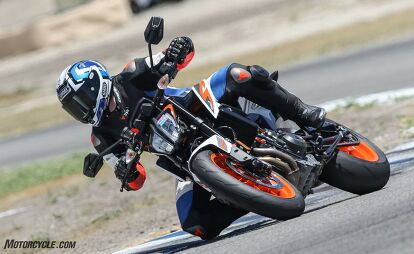
Helmet: Shoei X-14 Starting at $731 (Link is for solid white)
- Suit: Dainese Misano 2 D-Air Perforated Race Suit $2500
- Gloves: Dainese Full Metal 6 Gloves $430
Boots: Dainese Axial D1 Air Boots $530
Specifications | KTM 890 Duke R | Triumph Street Triple RS |
|---|---|---|
| MSRP | $11,699 | $12,550 |
| Engine Type | 890cc Liquid-cooled, Parallel-Twin | 765cc, liquid-cooled, Triple |
| Bore and Stroke | 96.0mm x 62.1mm | 77.99mm x 53.4mm |
| Fuel System | Programmed fuel-injection system (PGM-FI); DKK Dell’Orto 46mm throttle bodies | Multipoint sequential electronic fuel injection with SAI. Electronic throttle control |
| Compression Ratio | 13.5:1 | 12.54:1 |
| Valve Train | DOHC, four-valves per cylinder | DOHC, four valves per cylinder |
| Horsepower | 116.2 hp at 9500 rpm | 116.6 hp at 12100 rpm |
| Torque | 70.2 lb-ft at 6900 rpm | 56.3 lb-ft at 9300 rpm |
| Electronics | MTC (lean angle sensitive, 3-Mode disengageable + Track mode optional), 4 Ride Modes, Quickshifter Up/Down (optional), ABS (incl. Cornering-ABS and Supermoto) | Ride Modes, Up/Down Quickshifter, ABS, Traction Control (Non-IMU) |
| Transmission | 6-speed, Wet, multi-plate, cable operated w/slipper clutch | 6-speed, Wet, multi-plate, slip-assisted, with Triumph Shift Assist |
| Final Drive | X-Ring 520 chain | X-ring chain |
| Frame | Chromium-Molybdenum-Steel frame using the engine as stressed element, powder coated. Aluminum subframe | Front – Aluminum beam twin spar. Rear – 2-piece high pressure die cast |
| Front Suspension | WP APEX 43 (compression, rebound adjustable) 5.5-inch travel | Showa 41 mm upside down big piston forks (BPF), Adjustable compression damping, rebound damping and preload adjustment. |
| Rear Suspension | WP APEX Monoshock (Compression (high and low speed), rebound, hydraulic preload adjustable), 5.9 inches of travel | Öhlins STX40 fully-adjustable piggyback reservoir RSU |
| Front Brake | 2 × Brembo Stylema four piston, radially mounted caliper, brake disc Ø 320 mm | Twin 310 mm floating discs, Brembo M50 4-piston radial monobloc calipers |
| Rear Brake | Brembo single piston floating caliper, brake disc Ø 240 mm | “Single 220 mm disc, Brembo single-piston caliper, switchable ABS “ |
| Front Tire | Michelin Powercup II 120/70 ZR17 | Pirelli Diablo Supercorsa SP 120/70 ZR17 |
| Rear Tire | Michelin Powercup II 180/55 ZR17 | Pirelli Diablo Supercorsa SP 180/55 ZR17 |
| Rake/Trail | 24.3º / 3.9 in. (99.06mm) | 23.9º / 3.9 in. (99.06mm) |
| Wheelbase | 58.3 ± 0.6 inches | 55.3 in. |
| Seat Height | 32.8 | 32.5 in. |
| Curb Weight | 408 lbs. | 416 lbs. |
| Fuel Capacity | 3.7 gal. | 4.6 gal. |

Troy's been riding motorcycles and writing about them since 2006, getting his start at Rider Magazine. From there, he moved to Sport Rider Magazine before finally landing at Motorcycle.com in 2011. A lifelong gearhead who didn't fully immerse himself in motorcycles until his teenage years, Troy's interests have always been in technology, performance, and going fast. Naturally, racing was the perfect avenue to combine all three. Troy has been racing nearly as long as he's been riding and has competed at the AMA national level. He's also won multiple club races throughout the country, culminating in a Utah Sport Bike Association championship in 2011. He has been invited as a guest instructor for the Yamaha Champions Riding School, and when he's not out riding, he's either wrenching on bikes or watching MotoGP.
More by Troy Siahaan























































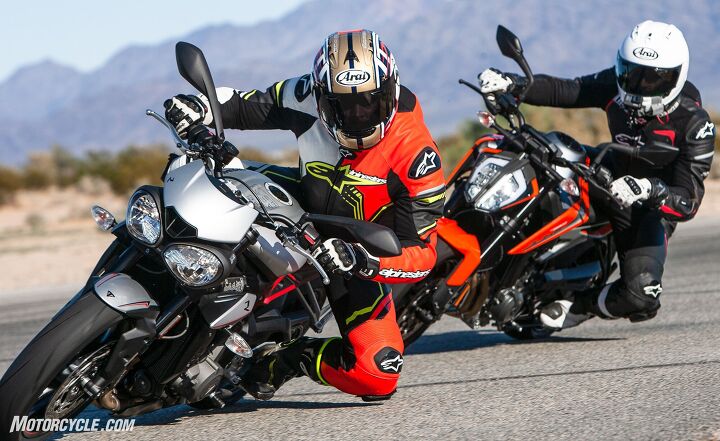
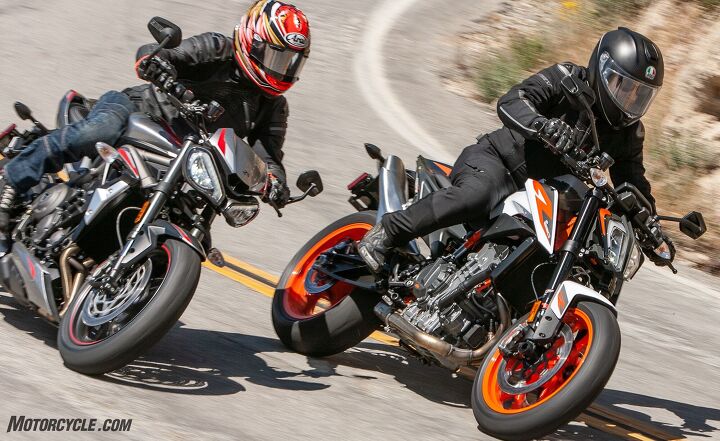


















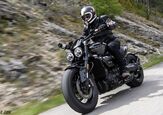


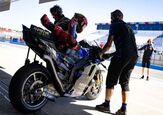








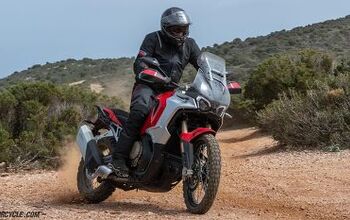









Comments
Join the conversation
Owned and have 25,000mi. on her and this is my opinion. Owned a Ducati Monster 1200R, way over rated and lost a ton of money when trying to sell her, took 1/1/yrs. to get a buyer for the Ducati even after pricing her at $2,000.00 below low blue book. Never again! My RS is used in canyons and tracking, had issues with slipping out of gear which was taken care of, the tranny is the worse and very harsh shifting I have ever experienced, like someone hit you in the rear with a sludge hammer, not smooth, it jumps. Had it checked and dealer said there was nothing wrong with it. Can't stand using the QS and use the clutch lever most of the time. The bike is no where a track bike, it will scrape and rear sets are over $600.00 that actually fit. After market goodies are very expensive if one wants them. RS is a good all around bike, rider stated that the bike ridden is like a sail which it is after 75mph. I have a extension on mine which does nothing. My bike weight is 420lbs. with a full tank. After selling this bike I will always buy Japanese bikes, reliability as well as parts availability! Hope my comment helps!
Lots of interesting comments regarding this comparison. Since I own a late model bike from both manufacturers, thought I'd chime in with my
2 years later I found myself in need of another bike and had decided I wanted a naked, fun bike. I was scouring Cycle Trader looking for a nice late model, slightly used Duke 690. I had ridden a couple and was impressed with how light and quick with a great motor, especially for a single, they had. I did find a couple, but then ran across an ad from a dealer in California for 2020 790 Dukes for $6995. That, of course wasn't the OTD price but it got me thinking. I read tons of online reviews and the universal theme seemed to be how much fun they were, how well they handled, poor fueling which was easily fixable. I contacted my local dealer and yes he had a black one and 2 orange ones. $8000 OTD plus tax and license. I immediately bought the black one. I can honestly say that I have not been disappointed. I took my time breaking it in, kept the revs below 6300 for the first 600 miles, no wheelies, no hard launches and mostly shifted with the clutch (old habits) I now have 900 miles on the bike, it has no oil weeping or leaks, the quickshifter works perfectly, the suspension has loosened up and the fueling is still a little rough. I'm not sure I'm going to bother doing anything about that as the transition from off throttle to on throttle coming out of corners is spot on. The online reviews were absolutely right. Cranking the throttle open coming out of corners produces a soul satisfying surge of power. The bike is so light and handles so well, it reminds me of my SV650 (first generation).
All of this just to say that both Triumph and KTM are building some wonderful bikes and that when choosing one or the other, a buyer would not be disappointed. I think the break-in on a KTM is possibly more important than on the Triumph.